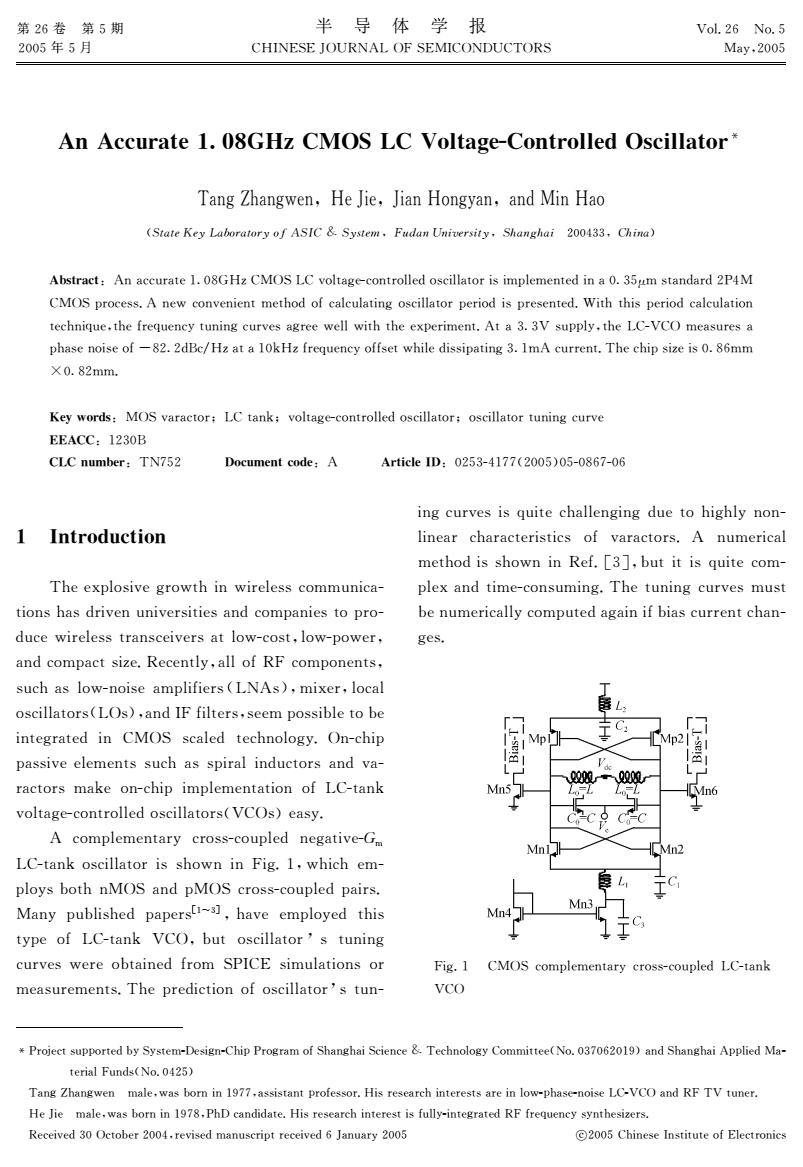正在加载图片...

第26卷第5期 半导体学报 Vol.26 No.5 2005年5月 CHINESE JOURNAL OF SEMICONDUCTORS May,2005 An Accurate 1.08GHz CMOS LC Voltage-Controlled Oscillator* Tang Zhangwen,He Jie,Jian Hongyan,and Min Hao (State Key Laboratory of ASIC 8.System.Fudan University,Shanghai 200433,China) Abstract:An accurate 1.08GHz CMOS LC voltage-controlled oscillator is implemented in a 0.35um standard 2P4M CMOS process.A new convenient method of calculating oscillator period is presented.With this period calculation technique,the frequency tuning curves agree well with the experiment.At a 3.3V supply,the LC-VCO measures a phase noise of -82.2dBc/Hz at a 10kHz frequency offset while dissipating 3.ImA current.The chip size is 0.86mm X0.82mm. Key words:MOS varactor:LC tank;voltage-controlled oscillator;oscillator tuning curve EEACC:1230B CLC number:TN752 Document code:A Article1D:0253-4177(2005)05-0867-06 ing curves is quite challenging due to highly non- 1 Introduction linear characteristics of varactors.A numerical method is shown in Ref.[3],but it is quite com- The explosive growth in wireless communica- plex and time-consuming.The tuning curves must tions has driven universities and companies to pro- be numerically computed again if bias current chan- duce wireless transceivers at low-cost,low-power, ges. and compact size.Recently,all of RF components, such as low-noise amplifiers (LNAs),mixer,local oscillators(LOs),and IF filters,seem possible to be L 口 integrated in CMOS scaled technology.On-chip Mp LMp2| passive elements such as spiral inductors and va- V ractors make on-chip implementation of LC-tank Mn5 0-0 HMn6 voltage-controlled oscillators(VCOs)easy. A complementary cross-coupled negative-Gm MnL Mn2 LC-tank oscillator is shown in Fig.1,which em- ploys both nMOS and pMOS cross-coupled pairs. Mn3 Many published papers[i-3],have employed this Mn4H type of LC-tank VCO,but oscillator's tuning 1工 curves were obtained from SPICE simulations or Fig.1 CMOS complementary cross-coupled LC-tank measurements.The prediction of oscillator's tun- VCO Project supported by System-Design-Chip Program of Shanghai Science &Technology Committee(No.037062019)and Shanghai Applied Ma- terial Funds(No.0425) Tang Zhangwen male,was born in 1977,assistant professor.His research interests are in low-phase-noise LC-VCO and RF TV tuner. He Jie male,was born in 1978,PhD candidate.His research interest is fully-integrated RF frequency synthesizers. Received 30 October 2004.revised manuscript received 6 January 2005 ©2005 Chinese Institute of Electronics第XW卷 第C期 X[[C年C月 半 导 体 学 报 NOLFV,V?R_6FE7R@,VQLNRF4_N’R6, \=%cXW F=cC Q*&!X[[C #K1=>$H28(..=12$#+&,&82$-/4$8"3)/N<".K1=31*-=A,<*)3<*",H"$)H$j ’$H<)=%=3&N=--"22$$"F=c[DP[WX[Y‘#*)#,<*)3<*"E..%"$#Q*/ 2$1"*%@()#8"F=c[aXC# ’*)3;<*)3]$) -*%$!]*8+=1)")Y‘PP!*88"82*)2.1=A$88=1cO"81$8$*1H<")2$1$828*1$")%=]/.<*8$/)="8$7N/\NR*)#6@’\2()$1c O$?"$ -*%$!]*8+=1)")Y‘PB!K<4H*)#"#*2$cO"81$8$*1H<")2$1$82"8A(%%&/")2$31*2$#6@A1$J($)H&8&)2<$8"U$18c 6$H$"G$#D[RH2=+$1X[[a!1$G"8$#-*)(8H1".21$H$"G$#W?*)(*1&X[[C &X[[CN<")$8$L)82"2(2$=AV%$H21=)"H8 "F"MMI?;>=C:.EQ0[/6%14/789>;R=P/8F>?899=K%@MH99;>8?# ’*)3;<*)3]$)!O$?"$!?"*)O=)3&*)!*)#Q")O*= ";J’J6&6:.’K-O’J-O:-5S;$! W ;:>J6<!207’(X()Y6O>)J:!;,’(*,’) X[[aDD!!,)(’# "J@>?;M>$E)*HH(1*2$YZ[B0OUNQR,7NG=%2*3$/H=)21=%%$#=8H"%%*2=1"8"-.%$-$)2$#")*[ZDC$-82*)#*1#XKaQ NQR,.1=H$88cE)$]H=)G$)"$)2-$2<=#=AH*%H(%*2")3=8H"%%*2=1.$1"=#"8.1$8$)2$#c!"2<2<"8.$1"=#H*%H(%*2"=) 2$H<)"J($!2<$A1$J($)H&2()")3H(1G$8*31$$]$%%]"2<2<$$T.$1"-$)2cE2*DZD\8(..%&!2<$7N/\NR -$*8(1$8* .<*8$)="8$=AgBXZX#5H%OU*2*Y[IOUA1$J($)H&=AA8$2]<"%$#"88".*2")3DZY-EH(11$)2c’<$H<".8"U$"8[ZBW-- f[ZBX--c S=<T8?K@$QR,G*1*H2=1&7N2*)I&G=%2*3$/H=)21=%%$#=8H"%%*2=1&=8H"%%*2=12()")3H(1G$ **"//$YXD[5 /4/FIOJ=?$’FPCX $8MIO=F>M8K=$E "?>HM9=’$$[XCD/aYPP"X[[C#[C/[BWP/[W C ’F>?8KIM>H8F ’<$$T.%=8"G$31=]2<")]"1$%$88H=--()"H*/ 2"=)8<*8#1"G$)()"G$18"2"$8*)#H=-.*)"$82=.1=/ #(H$]"1$%$8821*)8H$"G$18*2%=]/H=82!%=]/.=]$1! *)#H=-.*H28"U$c6$H$)2%&!*%%=A6@H=-.=)$)28! 8(H<*8%=]/)="8$*-.%"A"$18"7FE8#!-"T$1!%=H*% =8H"%%*2=18"7R8#!*)#L@A"%2$18!8$$-.=88"+%$2=+$ ")2$31*2$#") NQR, 8H*%$# 2$H<)=%=3&cR)/H<". .*88"G$$%$-$)288(H<*88."1*%")#(H2=18*)#G*/ 1*H2=18 -*I$=)/H<"."-.%$-$)2*2"=)=A7N/2*)I G=%2*3$/H=)21=%%$#=8H"%%*2=18"\NR8#$*8&c E H=-.%$-$)2*1& H1=88/H=(.%$# )$3*2"G$/@- 7N/2*)I=8H"%%*2=1"88<=])")@"3cY!]<"H<$-/ .%=&8+=2<)QR,*)#.QR,H1=88/H=(.%$#.*"18c Q*)& .(+%"8<$# .*.$18’Y’D(!<*G$ $-.%=&$#2<"8 2&.$=A 7N/2*)I \NR!+(2 =8H"%%*2=1)82()")3 H(1G$8]$1$=+2*")$#A1=- ,KLNV8"-(%*2"=)8=1 -$*8(1$-$)28c’<$.1$#"H2"=)=A=8H"%%*2=1)82()/ ")3H(1G$8"8J("2$H<*%%$)3")3#($2=<"3<%&)=)/ %")$*1 H<*1*H2$1"82"H8 =A G*1*H2=18cE )(-$1"H*% -$2<=#"88<=])")6$Ac’D(!+(2"2"8J("2$H=-/ .%$T*)#2"-$/H=)8(-")3c’<$2()")3H(1G$8-(82 +$)(-$1"H*%%&H=-.(2$#*3*")"A+"*8H(11$)2H<*)/ 3$8c @"3cY NQR,H=-.%$-$)2*1&H1=88/H=(.%$#7N/2*)I \NR